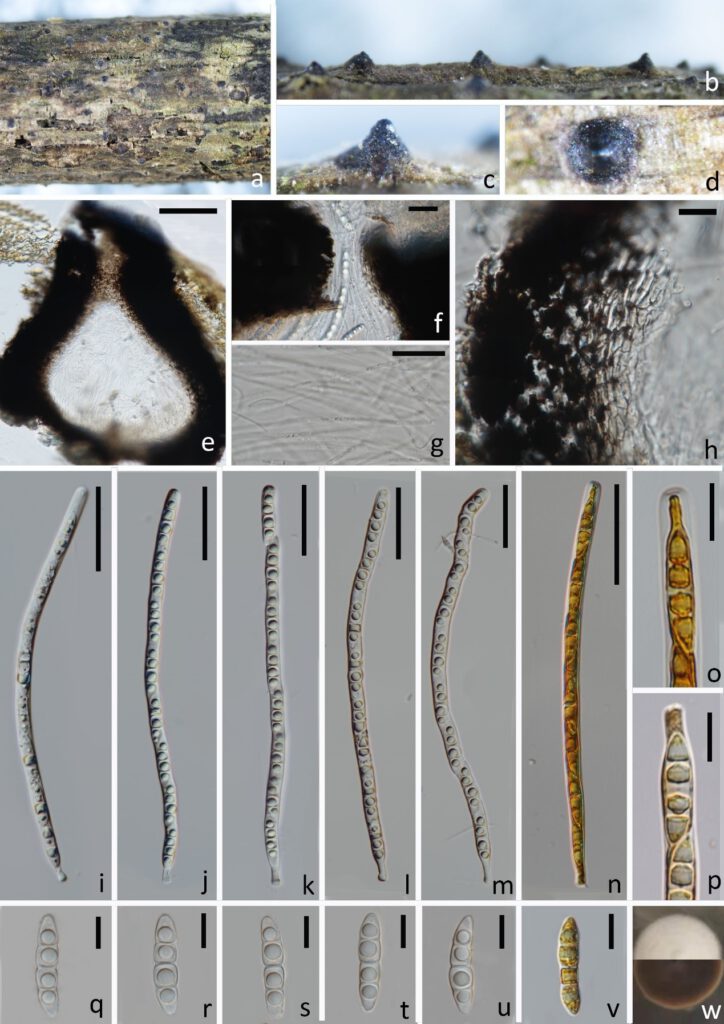Melomastia oleae W.L. Li, Maharachch. & Jian K. Liu, sp. nov
MycoBank number: MB 841500; Index Fungorum number: IF 841500; Facesoffungi number: FoF 10534;
Etymology: The species epithet refers to the host genus where the fungus was isolated
Holotype: HKAS 121315
Saprobic on dead branches of Olea europaea. Sexual morph: Ascomata 410–440 × 493–520 μm. ( = 425 × 506.5 μm, n = 15), visible as numerous, black, cone-like structures on host surface, solitary, gregarious, semi-immersed, globose to compressed globose, carbonaceous, dark brown to black, rough-walled, ostioles. Ostioles neck crest-like, 20.5–50 × 60–83 μm ( = 35 × 72 μm, n = 15), central, carbonaceous, dark brown to black, papillate, periphyses filling the ostiolar canal. Peridium 54–65 μm wide, two-layered, outer thick, carbonaceous and inner composed of 5–6 layers of hyaline cells of textura angularis to textura prismatica. Hamathecium composed of numerous, 2–2.5 μm wide, dense, filiform, unbranched, aseptate pseudoparaphyses. Asci 209–237 × 7.5–9 μm ( = 223 × 8 μm, n = 30), 8-spored, bitunicate, cylindrical, slightly flexuous, apically rounded with ocular chamber, cylindrical pedicellate 9–12 × 3.5–5.8 μm ( = 10.5 × 4.6 μm). Ascospores 28–34 × 6–7 μm (= 31 × 6.5 μm, n = 30), uniseriate, partial overlapping, fusiform with obtuse ends, hyaline, 3-septate, slightly constricted at the septa, with guttules in each cell. Asexual morph: Undetermined.
Culture characteristics: Colonies on PDA reaching 15 mm diam. after 2 weeks at 25 °C. Cultures from above white, dense, circular, margin entire, papillate; reverse dark brown.
Material examined: China, Sichuan Province, Chengdu City, Shuangliu District, Olive Base, 30°33.25′N, 103°99.62′E, at an altitude of 432 m (the foot of mountain), 30 January 2021, on dead branch of Olea europaea, W.L. Li, Z.P. Liu, T. Zhang, GL 031 (HKAS 121315, holotype; HUEST 21.0004, isotype), ex-type living culture CGMCC3.20619 = UESTCC 21.0004; ibid., GL 004 (HUEST 21.0003, paratype), living culture UESTCC 21.0003; ibid., at an altitude of 438 m (Mountain side), 27 march 2021, on dead branch of Olea europaea, W.L. Li, T. Zhang, GL 128 (HUEST 21.0005, paratype isotype), living culture UESTCC 21.0005; ibid., GL 135 (HUEST 21.0006, paratype), living culture UESTCC 21.0006.
GenBank numbers –LSU, ITS, SSU, TEF
Notes: Phylogenetic analysis results showed that Melosmatia oleae clustered with M. fusispora, M. thamplaensis and M. winteri, but represented a distinct clade with high support (100% ML BS, 100% MP BS, 1.00 PP). Melosmatia oleae share similar ascus shapes and ascospore with M. fusispore, M. thamplaensis and M. winteri. However, M. winteri and M. thamplaensis have shorter asci than M. oleae (165–189 μm vs. 114–160 μm vs. 209–237 μm). Melosmatia fusispora is easily differentiated from M. oleae by having non-carbonised peridium and relatively lager ascomata (528 × 572 μm vs. 425 × 506.5 μm). Additionally, tef1-α sequence comparison reveals 48 base pair differences without gaps across 875 nucleotides (5.48%) between two taxa.

Figure 2. Melomastia oleae (HKAS 121315, holotype). (a–d) Ascomata on the subtrate. (e) Verticle section of the ascoma. (f) Verticle section of the ostiole. (h) Peridium. (g) Paraphyses. (i–n) Asci (n in Lugol’s lodine). (o) ocular chamber in Lugol’s lodine. (p) pedicel in Lugol’s lodine. (q–v) Ascospora (v in Lugol’s lodine). (w) Upper and reverse view of the colony after 14d. Scale bars: e = 100 μm, f = 20 μm, g, h, o–v = 10 μm, i–n = 40 μm.
